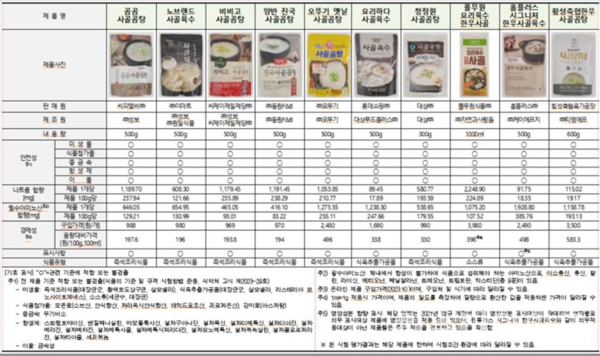
[Consumerwide - Youngchul Woo Reporter/ Yohan Bok Reporter] One of the representative convenience foods in Korea is meat soup, as consumers can enjoy a relatively healthy restaurant menu easily at home in the midst of high inflation.
However, it's been found that some of these products contain high sodium, accounting for 11.2% of the daily nutrition intake per product at maximum, according to the Daejeon Chungnam Consumers Union of Korea. The test assessed the safety, quality, and appropriateness of the 10 convenience food products (meat soup products), aiming to provide accurate data on them. (Gomgom Sagolgomtang, Nobrand Sagolyuksu, Bibigo Sagolgomtang, Yangban Jinguk Sagolgomtang, Ottogi Yetnal Sagolgomtang, Yorihada Sagolyuksu, Chungjeongwon Sagolgomtang, Pulmuone Yoriyuksu Hanwoosagol, Homeplus Signiture Hanwoosagolyuksu, Hoengsungchukhyuphanwoo Sagolgomtang)
According to the Daejeon Chungnam Consumers Union of Korea, on March 19, there was an issue of sodium in some of the meat soup products. The amount of sodium varies at a maximum of 13.3 times per 100g, and some products contain a maximum of 112.4% of their daily sodium intake (per whole product).
2000mg of sodium is standard for daily nutrition intake. But the amount of sodium varied at a maximum 13.3 times per 100g (between 0.9% and 11.9%). Yangban Jinguk Sagolgomtang (dongwon) contained 238.29mg of sodium, which is 11.9% of daily nutrition intake, but Sagolyuksu (Lotte) had the least sodium by recording 17.89mg, which is only 0.9% of daily nutrition intake.
The amount of sodium per product varied at a maximum 25.1% (between 4.5% and 112.4%) in daily nutrition intake. Sodium in Pulmuone Yoriyuksu Hanwoosagol reached 2,248.90mg, which is 112.4% of the daily nutrition intake. On the other hand, sodium in Sagolyuksu (Lotte) reached 89.45mg (4.5% of daily nutrition intake). Besides, the sodium in Gomgom Sagolgomtang (CLB), Bibigo (CJ) Sagolgomtang, Yangban (Dongwon) Jinguk Sagolgomtang, and Ottogi Yetnal Sagolgomtang reached approximately half of the daily nutrition intake. Thus, consumers have to be aware when they purchase them.
Daejeon Chungnam Consumers Union of Korea recommended that consumers take food with calium when they take food that contains high sodium while aware of nutrition information on products. In practical steps, consumers are advised to cook foods with high sodium in small portions (divide by 2~3 times) along with spinach and water parsley, which contain a large amount of calium.
The amount of amino acids varied at a maximum 4.6 times between products. The nine amino acids (essential)—histidine, isoleucine, leucine, lysine, methionine, phenylalanine, threonine, tryptophan, and valine—are not synthesised by mammals and are therefore dietarily essential or indispensable nutrients. (NIH) Homeplus Signiture Hanwoosagolyuksu had the most amino acids by recording 1,928.80 mg, while Yangbanjinguk Sagolgomtang had the least by recording 416.10mg. Regarding safety, all the tested products passed the safety level without any issues with microbes, food additives, heavy metals, antibiotics, alien substances, or mark compatibility.
The cost gap varied between 193.8 won and 583.3 won (an average of 342.5 won) per 100 g (100 ml), which was at most 3 folds. Bibigo Sagolgomtang (CJ) was the cheapest at 193.8 won, while Hoengsungchukhyuphanwoo Sagolgomtang was the most expensive at 583.3 won.

